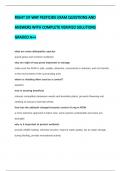Tentamen (uitwerkingen)
International Strategy Exam Multiple Choice Questions Vrije Universiteit Amsterdam IBA 2024
- Instelling
- Vrije Universiteit Amsterdam (VU)
The International Strategy Multiple Choice Exam for International Business Administration students at the Vrije Universiteit (VU) is a comprehensive exam that covers key concepts and theories related to international strategy. This exam is designed to help students gain a basic understanding of the...
[Meer zien]














